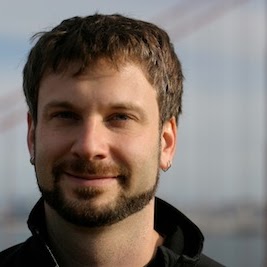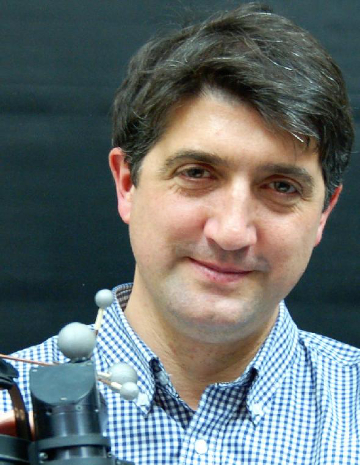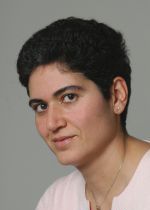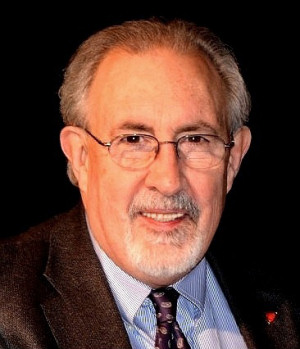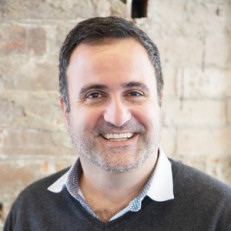

The World's Premier Conference for 3D Innovation
 |
Videos of many of the presentations at the conference are available for free viewing by clicking on the special "Video" icons |
Hyatt Regency San Francisco Airport Hotel, Burlingame, California USA, USA.
To be published open-access as part of the IS&T Proceedings of Electronic Imaging.
Part of IS&T's International Symposium on Electronic Imaging: Science and Technology
Sunday-Thursday 28 January - 1 February 2017 ¤ Hyatt Regency San Francisco Airport, Burlingame, California, California, USA.
[ Advance Program: Day 1, Day 2, Day 3, Keynote 1, Keynote 2, Demonstration Session, 3D Theatre, Discussion Forum ] [ Register, Short Course ]
|
|
| Monday 29th January 2018 |
| SESSION 1 Stereoscopic Developments Session Chair: Takashi Kawai, Waseda University (Japan) |
Mon. 8:50 - 10:10 AM |
8:50 am: Use of VR to assess and treat weaknesses in human stereoscopic vision, Benjamin Backus, James Blaha, Manish Gupta, Brian Dornbos, and Tuan Tran, Vivid Vision, Inc. (United States) [SD&A-109]
  |
9:10 am: Emotional effects of car-based motion representations with stereoscopic images, Ryo Kodama and Nobushige Fujieda, Toyota Central R&D Labs, Inc.; Jo Inami, Yusuke Hasegawa, and Takashi Kawai, Waseda University (Japan) [SD&A-110]
 |
9:30 am: Mid-air imaging technique for architecture in public space, Ayaka Sano and Naoya Koizumi, The University of Electro-Communications (Japan) [SD&A-111]
  |
9:50 am: A Refocus-Interface for Diminished Reality Work Area Visualization, Hideo Saito, Keio University; Momoko Maezawa and Shohei Mori, Keio University (Japan) [SD&A-112]
  |
| SD&A Conference Opening Remarks by Andrew Woods, Curtin University (Australia) |
Mon. 10:10 am - 10:20 pm
|
| Coffee Break | Mon. 10:20 - 10:50 am |
| SESSION 2 Autostereoscopic Displays 1: Light-field Session Chair: John Stern, Intuitive Surgical, Inc. (United States) |
Mon. 10:50 am - 12:30 pm |
10:50 am: Initial work on development of an open Streaming Media Standard for Field of Light Displays (SMFoLD), Jamison Daniel, Benjamin Hernandez Arreguin, Oak Ridge National Laboratory; Stephen Kelley, C. E. (Tommy) Thomas, Paul Jones, Third Dimension Technologies; Chris Chinnock, Insight Media (United States) [SD&A-140]
  |
11:10 am: Simulation tools for light-field displays based on a micro-lens array, Weitao Song, Nanyang Technological University (Singapore) and Advanced Innovation Center for Future Visual Entertainment (China); Dongdong Weng, Yue Liu, and Yongtian Wang, Advanced Innovation Center for Future Visual Entertainment and Beijing Institute of Technology (China) [SD&A-141]
 |
11:30 am: Full-parallax spherical light field display using mirror array, Hiroaki Yano and Tomohiro Yendo, Nagaoka University of Technology (Japan) [SD&A-142]
  |
11:50 am: Fast calculation method for full-color computer-generated hologram with real objects captured by a depth camera, Yu Zhao1, Shahinur Alam1, Seok-Hee Jeon3, and Nam Kim2; 1Chungbuk National University and 3Incheon National University (Republic of Korea) [SD&A-250]
  |
12:10 pm: Conversion of sparsely-captured light field into alias-free full-parallax multiview content, Suren Vagharshakyan, Robert Bregovic, Atanas Gotchev; Erdem Sahin, Tampere University of Technology (Finland); Gwangsoon Lee, ETRI (North Korea) [SD&A-144]
  |
| Lunch Break | Mon. 12:30 - 2:00 pm |
|
| Coffee Break | 3:00 - 3:30 pm |
|
| EI 2018 Symposium Reception The annual Electronic Imaging All-Conference Reception provides a wonderful opportunity to get to know and interact with new and old SD&A colleagues. Plan to join us for this relaxing and enjoyable event. |
Mon. 5:00 - 6:00 pm |
This ever-popular session of each year's Stereoscopic Displays and Applications Conference showcases the wide variety of 3D content that is being produced and exhibited around the world. All 3D footage screened in the 3D Theater Session is shown in high-quality polarized 3D on a large screen. The final program will be announced at the conference and 3D glasses will be provided.
|
The annual informal dinner for SD&A attendees. An opportunity to meet with colleagues and discuss the latest advances. There is no host for the dinner. Information on venue and cost will be provided on the day at the conference. |
| Tuesday 30th January 2018 |
| SESSION 3 Stereoscopic Applications: VR to Immersive Analytics in Bioinformatics 1 (Joint Session) Session Chair: Björn Sommer, University of Konstanz (Germany) This session is jointly sponsored by: Stereoscopic Displays and Applications XXIX and The Engineering Reality of Virtual Reality 2018. |
Tue. 8:50 - 10:10 AM |
8:50 am: Mesoscopic rigid body modeling of the ExtraCellular Matrix's self assembly, Hua Wong, Nicolas Belloy, and Manuel Dauchez, University of Reims Champagne-Ardenne (France) [SD&A-189]
  |
9:10 am: Semantics for an integrative and immersive pipeline combining visualisation and analysis of molecular data, Mikael Trellet2, Nicolas Ferey2, Patrick Bourdot2, and Marc Baaden1; 1IBPC and 2LIMSI (France) [SD&A-190]
  |
9:30 am: 3D-stereoscopic modeling and visualization of a Chlamydomonas reinhardtii cell, Niklas Biere4, Mehmood Ghaffar4, Daniel Jäger4, Anja Doebbe4, Nils Rothe4, Karsten Klein2,3, Ralf Hofestädt4, Falk Schreiber1,3, Olaf Kruse4, and Björn Sommer1,3; 1University of Konstanz, 2University of Konstanz, Germany, 3Monash University (Australia), and 4Bielefeld University (Germany) [SD&A-191]
 |
9:50 am: Immersive analysis and visualization of redox signaling pathways integrating experiments and computational modelling, , Alexandre Maes2, Karen Druart1, Sean Guégan1, Xavier Martinez1,3, Christophe Marchand2, Stéphane Lemaire2, and Marc Baaden1; 1Laboratoire de Biochimie Théorique, CNRS, UPR9080, Univ Paris Diderot, Sorbonne Paris Cité, PSL Research University, 2Institut de Biologie Physico-Chimique, UMR8226, CNRS, Sorbonne Universités, UPMC Université Paris 06, and 3CNRS-LIMSI, VENISE team, Univ Paris-Sud (France) [SD&A-192]
  |
| Coffee Break | Tues. 10:30 - 10:50 am |
| SESSION 4 Autostereoscopic Displays 2: Volumetric, Integral, Stackable, and Holographic Session Chair: Gregg Favalora, Draper (United States) |
Tue. 10:50 am - 12:30 pm |
10:50 am: Recent progress in volumetric 3D digital light photoactivatable dye displays, Shreya Patel, Jian Cao, Anthony Spearman, Cecilia O'Brien, and Alexander Lippert, Southern Methodist University (United States) [SD&A-246]
 |
11:10 am: Integral imaging system using locally controllable point light source array, Hayato Watanabe, Masahiro Kawakita, Naoto Okaichi, Hisayuki Sasaki, and Tomoyuki Mishina, Science and Technology Research Laboratories, NHK (Japan Broadcasting Corporation) (Japan) [SD&A-247]
 |
11:30 am: Mobile integral imaging display using three-dimensional scanning, Munkh-Uchra1 Erdenebat1, Ki-Chul Kwon2, Erkhembaatar Dashdavaa3, Jong-Rae Jeong4, and Nam Kim1; 1Chungbuk National University and 4Suwon Science College (Republic of Korea) [SD&A-248]
  |
11:50 am: Constructing Stackable Multiscopic Display Panels Using Microlenses and Optical Waveguides , Hironobu Gotoda, National Institute of Informatics (Japan) [SD&A-249]
 |
12:10 pm: Angular and Spatial Sampling Requirements in 3D Light Field Displays, Hong Hua, The University of Arizona (United States) [SD&A-143]
 |
| Lunch Break | Tues. 12:30 - 2:00 pm |
|
| Coffee Break | Tues. 3:00 - 3:30 pm |
Moderator: Andrew Woods, Curtin University |
| SESSION 5 Stereoscopic Applications: VR to Immersive Analytics in Bioinformatics 2 Session Chair: Marc Baaden, IBPC (France) |
Tue. 4:30 - 5:30 pm |
This session is jointly sponsored by: The Engineering Reality of Virtual Reality 2018, and Stereoscopic Displays and Applications XXIX.
4:30 pm: Interactive molecular graphics for augmented reality using HoloLens, Christoph Müller, Michael Krone, Markus Huber, Verena Biener, Guido Reina, Daniel Weiskopf, and Thomas Ertl, University of Stuttgart (Germany) [SD&A-288]
  |
4:50 pm: Molecular Dynamics Visualization (MDV): Stereoscopic 3D display of biomolecular structure and interactions using the Unity game engine, Michael Wiebrands, Chris Malajczuk, Andrew Woods, Andrew Rohl, and Ricardo Mancera, Curtin University (Australia) [SD&A-289]
  |
| ||
|
Demonstrations
A symposium-wide demonstration session will be open to attendees 5:30 to 7:30 pm Tuesday evening. Demonstrators will provide interactive, hands-on demonstrations of a wide-range of products related to Electronic Imaging. The demonstration session hosts a vast collection of stereoscopic products providing a perfect opportunity to witness a wide array of stereoscopic displays with your own two eyes. More information: http://www.stereoscopic.org/demo/index.html. |
| Wednesday 31st January 2018 |
| SESSION 6 Stereoscopic History Session Chair: Nicolas Holliman, University of Newcastle (United Kingdom) |
Wed. 8:50 - 9:10 am |
8:50 am: The History of Stereoscopic Video Games for the Consumer Electronic Market, Ilicia Benoit, NYSA (United States) [SD&A-290]
 |
|
| Coffee Break | Wed. 10:10 - 10:40 am |
|
SESSION 7 This session is jointly sponsored by: Photography, Mobile, and Immersive Imaging 2018; The Engineering Reality of Virtual Reality 2018; and Stereoscopic Displays and Applications XXIX |
Wed. 11:20 am - 12:40 pm |
11:20 am: SpinVR: Towards Live-Streaming 3D Virtual Reality Video, Donald Dansereau, Robert Konrad, Aniq Masood, and Gordon Wetzstein, Stanford University (United States) [PMII-350]
 |
11:40 am: Towards a full parallax cinematic VR system, Haricharan Lakshman, Dolby Labs (United States) [PMII-351]
Noon: Perceptual Evaluation of Six Degrees of Freedom Virtual Reality Rendering from Stacked Omnistereo Representation , Jayant Thatte and Bernd Girod, Stanford University (United States) [PMII-352]
  |
12:20 pm: Image systems simulation for 360° camera rigs , Trisha Lian, Joyce Farrell, and Brian Wandell; Stanford University (United States) [PMII-353]
  |
| Lunch Break | Wed. 12:40 - 2:00 pm |
|
| Coffee Break | Wed. 3:00 - 3:30 pm |
| SESSION 8 Visualization Facilities (Joint Session) Session Chairs: Margaret Dolinsky, Indiana University (United States) and Andrew Woods, Curtin University (Australia) This session is jointly sponsored by: The Engineering Reality of Virtual Reality 2018, and Stereoscopic Displays and Applications XXIX. |
Wed. 3:30 - 5:10 pm |
3:30 pm: xREZ Art + Science Lab - Facilities Presentation, Ruth West, University of North Texas (United States) [ERVR-392]
3:50 pm: CADwalk: life-size MR-AR-VR design experience - optimising and validating mission critical work environments, Gerhard Kimenkowski, CADwalk Global Pty Ltd (Australia) [SD&A-393]
4:10 pm: When One Is Not Enough: Cross-Platform And Collaborative Developments At The Emerging Analytics Center, Dirk Reiners, Carolina Cruz-Neira, and Carsten Neumann, University of Arkansas at Little Rock (United States) [ERVR-394]
 |
4:30 pm: Multiplatform VR case study - Beacon Virtua, Andrew Woods1, Nick Oliver1, and Paul Bourke2; 1Curtin University and 2University of Western Australia (Australia) [SD&A-395]
 |
4:50 pm: What Will We See Next? Current Visualization Facilities Trends and Future Considerations, Mike Pedersen, Mechdyne Corp. (United States) [SD&A-396]
 |
| SD&A Conference Closing Remarks by Nicolas Holliman, Newcastle University (United Kingdom) |
Wed. 5:10 pm - 5:30 pm
|
| Stereoscopic Displays and Applications XXIX
Interactive Papers (Poster) Session The following works will be presented at the EI 2018 Symposium Interactive Papers Session on Wednesday evening, from 5:30 pm to 7:00 pm. Refreshments will be served. |
Wed. 5:30 - 7:00 pm |
- Computer-generated holography method based on orthographic projection using depth camera, Yan-Ling Piao1, Seo-Yeon Park1, Hui-Ying Wu1, Sang-Keun Gil2, and Nam Kim1; 1Chungbuk National University and 2Suwon University (Republic of Korea) [SD&A-410]

- Full-parallax and high-quality multiview 3D image acquisition method using camera slider, Byeong-Jun Kim, Ki-Chul Kwon, Jae-Min Lee, Young-Tae Lim, and Nam Kim, Chungbuk National University (Republic of Korea) [SD&A-411]

- Projection type light field display using undulating screen, Masahiro Kajimoto and Tomohiro Yendo, Nagaoka Univ. of Technology (Japan) [SD&A-412]

- Study of eye tracking type super multi-view display using time division multiplexing, Yuta Takahashi and Tomohiro Yendo, Nagaoka University of Technology (Japan) [SD&A-413]



